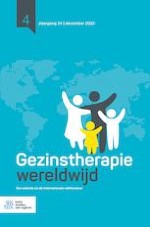21-11-2023
Het effect van zelfregulatie en partnerregulatie op de kwaliteit van de partnerrelatie
Gepubliceerd in: Gezinstherapie Wereldwijd | Uitgave 4/2023
Log in om toegang te krijgenSamenvatting
Onderzoek naar zelfregulatie- en partnerregulatiestrategieën volgde tot op heden twee parallelle onderzoekslijnen, en dus is het moeilijk om vast te stellen wat de relatieve bijdrage is van beide vormen van regulatie op relatie-uitkomsten. Het is dan ook de vraag welke regulatievorm sterker gecorreleerd is met de kwaliteit van de relatie; is het voor relatie beter om je te richten op adaptieve zelfregulatie, of op de adaptieve strategieën voor de regulatie van je partner? In dit onderzoek willen we deze belangrijke kloof dichten door de relatieve correlatie van adaptieve zelfregulatiestrategieën te vergelijken met de adaptieve partner-regulatiestrategieën voor de kwaliteit van de partnerrelatie. Een bevolkingssteekproef van koppels van verschillend geslacht (N = 114) – koppels die voor het merendeel tevreden waren met hun relatie, maar die soms toch een conflict in hun relatie hadden –, kreeg een zelfrapportage vragenlijst voorgelegd over verschillende zelfregulatie- en partnerregulatiestrategieën en over de kwaliteit van hun relatie. De koppels voerden daarnaast een gesprek over een onopgelost relatieprobleem, een gesprek dat werd opgenomen op video en dat door getrainde codeerders werd gecodeerd voor verbale en non-verbale indicatoren van zelfregulatie- en partnerregulatiestrategieën. Uit actor-partner interdependence modellen blijkt dat voor zowel mannen als vrouwen geldt dat adaptieve zelfregulatiestrategieën positief gecorreleerd zijn met hun eigen evaluatie van de kwaliteit van de relatie en met de evaluatie van de relatiekwaliteit door hun partner. Adaptieve partnerregulatiestrategieën zijn daarentegen niet significant gecorreleerd met de zelf ervaren kwaliteit van de eigen relatie van mannen en vrouwen of met die van hun partner. Uit deze bevindingen blijkt het belang van zelfregulatiestrategieën binnen relaties, omdat deze strategieën een positiever effect hebben op de kwaliteit van de relatie van koppels die in het algemeen tevreden zijn over hun relatie dan partnerregulatiestrategieën.
